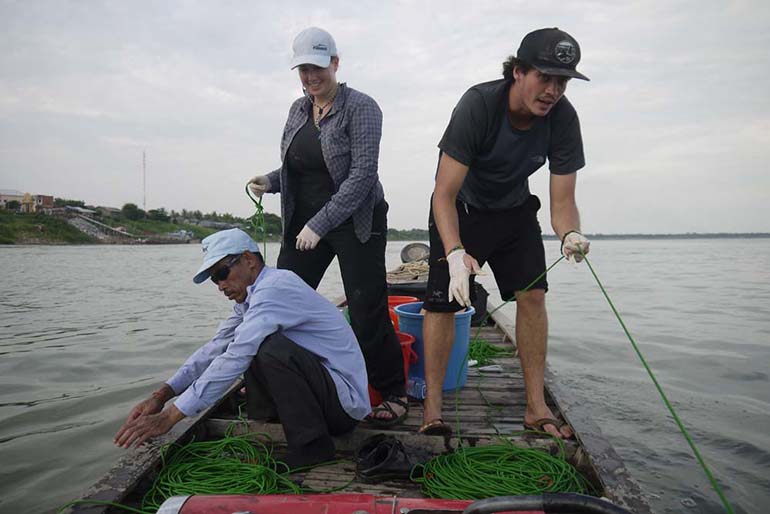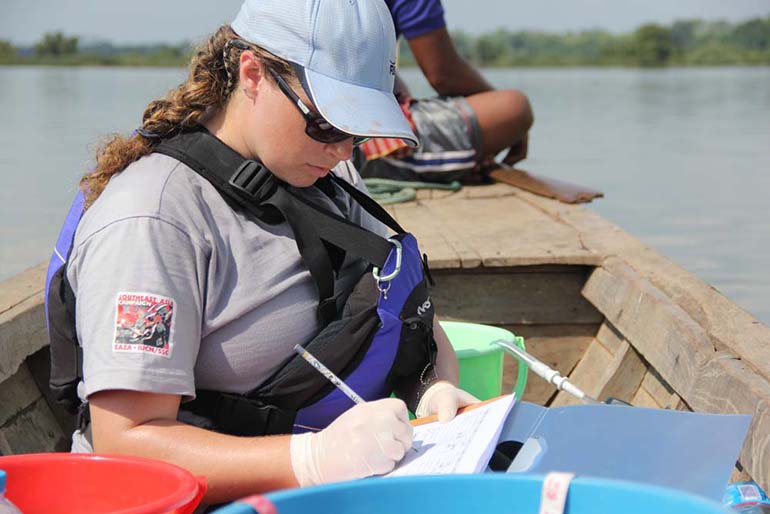
It began two decades ago with a spoonful of frozen soil. DNA fragments extracted from the depths of the Siberian earth allowed scientists to reconstruct an entire ice age ecosystem, painting a vivid picture of the mammoths, bison and other long-dead creatures that roamed the frozen steppes thousands of years ago. The literally ground-breaking study revealed that DNA is all around us, released as faeces, urine or skin tissue. This method of gathering traces of animals’ genetic code from the wider world, known as environmental DNA – or eDNA for short – is a rapidly expanding field of molecular biology that may hold the key to monitoring Southeast Asia’s fast-changing ecosystems.
Enter the Mekong giant catfish. When scientists and conservationists in Southeast Asia wanted to test the eDNA method to target a threatened species in tropical waters, this enormous animal – the largest freshwater fish in the world – was an obvious choice. Despite many local people viewing the catfish as a sacred animal, the species has been decimated in recent years, likely due to overfishing and habitat degradation, with conservation organisations now categorising the once-thriving fish as ‘critically endangered’.
Conservation scientist Thomas Gray, the director of Science and Global Development at Wildlife Alliance who worked with WWF Cambodia in studying the catfish, told Southeast Asia Globe that his team had targeted the species in order to road-test eDNA as a possible conservation planning method that might succeed where traditional monitoring methods have struggled.
Winding through four different nations in mainland Southeast Asia, the Mekong River’s sheer size and complexity pose a steep challenge for conservationists and scientists who monitor life in such bodies of water – particularly in a time when rapid population growth, industrial development and rising human consumption are expected to have a profound impact on the river’s biodiversity.
“We looked at six key places in Laos, Thailand and Cambodia where the catfish should have been – but only found it in one sample from the species’ presumed spawning grounds on the Mekong mainstream, near the border between northern Thailand and Laos,” he said.
Another challenge is that in order to identify a species, its DNA-code has to already be present in a reference library such as GenBank, an open access genetic sequence database. If the species’ DNA is not there, it must be added manually, which is an arduous task. For the giant catfish, there was no code in the library – meaning Gray’s team had to get it first elsewhere and then enter it into the library to see if they had a match.
“From one of the ponds where the Thai Fisheries Department keeps catfish, we obtained a tissue sample, analysed it and put the DNA code into GenBank,” explained Gray. “When we got the data from our Mekong water samples, we compared it with the catfish data in GenBank and found the one location of the catfish. It was a little surprising and disappointing to find the catfish in only one place.”

Draining task
In a more exotic use of the eDNA method, scientists collected more than 3,000 leeches in 21 locations across the rainforests of Laos, Vietnam and Malaysia. The idea is simple: while the remote jungles of Southeast Asia are home to a number of leopards, tigers and other endangered species, actually tracking these animals down to record their genetic code can be frustrating – not to mention dangerous.
Out wriggles leeches. These small spineless bloodsuckers feed on host animals – all you need to do is to catch leeches, isolate the DNA from the host animals’ ingested blood and compare it with data in the library. Gray, who tried this method to find the elusive saola, an antelope-like animal often dubbed the Asian unicorn, said that the method was not the holy grail he’d hoped for.
”Finding the leeches is not difficult – they will find you,” Gray said. “We were looking for the saola in the Annamite mountains between Laos and Vietnam, as this ungulate species has never been seen in the wild by scientists. The problem was the same as with the catfish: there was no saola DNA-code in the library.”
‘Needle in a haystack’
Southeast Asia is one of the world’s most bio-diverse regions, with a large variety in ecosystems in its forests, rivers and coral reefs. But its genetic variety is still largely untapped by scientists, who are working feverishly to catch up. Last year Michael Stat, a marine biologist at Macquarie University in Australia, compared two different eDNA-approaches on one of Earth’s most biodiverse ecosystems – a tropical coral reef.
“In the first approach we analysed all DNA in the water,” Stat said. “When we did that we predominantly got bacteria, because they are by far the most abundant in the water column. But you also get lots of DNA-fragments with no DNA-code in the library. The second approach targets specific animal groups using a kind of molecular telescope, which is basically like looking for a needle in a haystack: you can zoom in and pull out that needle.”
Using the second approach, Stat and his team found around 300 organisms including fish, crustaceans, mammals and plants. With a larger DNA library, he said, even more organisms could have been detected. “Basically we need to go out on the reef and take tissue samples of all life we encounter, analyse it and fill it into the GenBank library,” he said.
Despite these mixed results, Stat is optimistic about the prospects of the technique becoming mainstream.
“There is a lot of traction with this methodology… because a lot of data can be generated quickly,” he said. “It is definitely going to be included in the monitoring programmes in the future worldwide. The method is already being implemented across the globe, and that will increase as the technique [gets] better and cheaper and more reference codes become available.”
Gray was less optimistic about the method…at least in the region, given its lack of resources.
“The genetic laboratory at the Royal University of Phnom Penh is pretty good, and there has been some investments,” said Gray. “The laboratory can do DNA from tissue samples – e.g., from elephants to estimate the elephant population size. But to do it on eDNA samples is more complicated, because the pieces of DNA are smaller and the chance of contamination is higher. I don’t think any of the laboratories in the Mekong area are at that level yet.”


